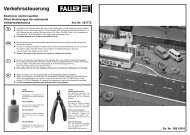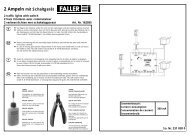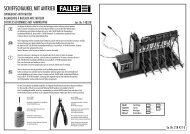INSTRUCTION MANUAL
INSTRUCTION MANUAL
INSTRUCTION MANUAL
Create successful ePaper yourself
Turn your PDF publications into a flip-book with our unique Google optimized e-Paper software.
Decoder MX620 - MX622, MX630 - MX632 Sound Decoder MX640 - MX648 Page 55<br />
is set back on the track within a minute or so. Using the above-mentioned resistor would erase the<br />
memory after just a few seconds.<br />
ZIMO offers a collection of components under the part number SPEIKOMP that are needed when<br />
building a do-it-yourself energy module for ZIMO MX620, MX63, MX64, MX630 and MX640 decoders.<br />
The set contains a diode, resistors, choke coil and a few capacitors (larger capacitors supplied<br />
by the user can and should be used if sufficient space is available inside the engine).<br />
Smart stop management on “dead” track sections:<br />
If power to the decoder is interrupted due to dirty rails, wheels or insulated frogs, the decoder automatically<br />
keeps the engine going even if the engine is supposed to come to a stop. The engine is allowed<br />
to come to a full stop as soon as power to the decoder is restored. With the engine stopped<br />
the decoder tests again for track power and if needed moves the engine another very short distance<br />
until track power again is restored. Power for the engine during “smart stopping” is of course coming<br />
from the capacitor. This prevents a situation where an engine is parked on dirty track and later can’t<br />
drive away, due to normal internal power dissipation of capacitors over time.<br />
MX632V, MX632W, MX632VD, MX632WD -<br />
the special MX632 design with built-in low voltage supply<br />
These decoders contain an efficient 1.5V or 5V regulator, which can be directly connected to low<br />
voltage bulbs. The low voltage is available at the purple wire and is used for the corresponding loads<br />
in place of the “common positive” (blue) wire.<br />
MX632V and MX632VD (1.5V) decoders facilitate the installation considerably especially in high<br />
quality brass models (which are often equipped with such bulbs), because it eliminates the installation<br />
of an external voltage regulator (that often requires some sort of heat dissipation).<br />
MX632W and MX632WD (5V) decoders are primarily meant for large scale engines (i.e. LGB) that<br />
are often equipped with 5V bulbs. The 5V supply can also be used to drive servos, which eliminates<br />
the need for an external voltage regulator.<br />
MX640, MX642, MX643, MX644, MX645, MX646 -<br />
connecting smoke generators to steam and diesel engines:<br />
With a “Seuthe” 18V smoke generator as example:<br />
In addition to a simple ON/OFF function with a function output of your choice, the MX640/MX642 is<br />
also capable to adapt the smoke volume to the load (almost no smoke at standstill, little smoke at<br />
cruising, heavy smoke at start-up etc.).<br />
This requires the smoke generator to be connected to one of the function outputs FO1 to FO6 and<br />
the selected output must be programmed with the associated special effect CV (with CV #127 for<br />
FO1, CV #128 fir FO2 etc.) for the desired effect; in this case for load dependent smoke for steam<br />
engines (effect code “72”) or load dependent smoke for diesels (effect code “80”).<br />
EXAMPLE: - Steam engine, smoke generator connected to function output FO5: CV #131 = 72.<br />
The selected function output is further defined by CV #137, 138 and 139 (“Definition of smoke generator<br />
characteristic”). These CV’s must be programmed with appropriate values otherwise the<br />
smoke generator will not produce any smoke.<br />
EXAMPLE: - Typical characteristic for a track voltage set around 20V with above smoke generator:<br />
CV #137 = 70…90: little smoke at standstill.<br />
CV #138 = 200: The smoke generator output is increased to about 80% of its maximum capacity<br />
beginning with speed step 1 (lowest speed step), which produces relatively heavy smoke.<br />
CV #139 = 255: The smoke generator is driven to its maximum, which results in thick smoke under<br />
heavy acceleration.<br />
Synchronized steam chuffs or typical diesel smoke with fan-controlled smoke generators:<br />
The MX640, MX642, MX645….. can produce steam puffs, with the help of a smoke generator with<br />
built-in fan, that are synchronized with the chuff sound or load dependent diesel smoke (i.e. diesel<br />
engine smoke at start-up, controlled by the sound project) without additional electronic components.<br />
The heating element of the smoke generator is connected – as in the example above with the<br />
“Seuthe” generator – on FO1…FO6 and configured with the appropriate CV for the desired effect<br />
(i.e. “72” for steam or “80” for diesel).<br />
The fan is connected to the function output FO4 (with MX620-MX632 and MX646 FA2); the other<br />
wire of the fan motor often requires a low voltage (check with the manufacturer) and is therefore<br />
connected to an external voltage regulator or to the 5V supply of the decoder, if 5V is suitable for the<br />
fan motor.<br />
The CV’s must be programmed as follows:<br />
CV #137, #138, #139 = 60, 90, 120 respectively: (IMPORTANT) if the heating element cannot operate<br />
at full track voltage; the voltage at the function output must be limited, which is done with suitable<br />
values in CV #137, 138 and 139.<br />
CV #133 = 1: (IMPORTANT) this configures output FO4 as a fan output.<br />
CV #353 = …i.e. 10: shuts the smoke generator off automatically to prevent overheating. In this<br />
example (10) after 250 seconds.<br />
CV #351, #352 = …: Only for diesel engines when special effect code “80” is selected in the<br />
applicable CV for FO1…FO6. This defines the fan speed (voltage) for start-up<br />
(default: maximum smoke) and cruising (default: medium smoke); see CV table.<br />
CV #355 =…: For steam and diesel engines. Defines the fan speed (voltage) at standstill (usually for<br />
very little smoke output).










